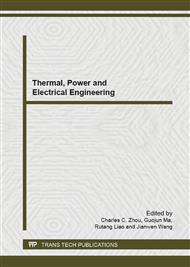[4]
through the analysis of ITAE integral comprehensive index when the generalized controlled object time constant and pure time delay change, it proved that when the time constant and pure time delay vary in a wide range, the improved Smith predictive control still has a strong adaptability. 2.3 Design of Fuzzy PID compound controller Accounting for the characters of the controlled object, this paper proposes to substitute Fuzzy PID compound controller for the main regulator of cascade control system so as to improve the dynamic performance and anti-disturbance capacity when the load has been greatly changed. The structure figure of the control system is shown in Fig. 4. Tab. 1 Control rules of fuzzy control Fig. 4 Fuzzy PID compound control system NB
NM
NS
ZO
PS
PM
PB
NB
PB
PB
PB
PM
PS
PS
PS
NM
PB
PB
PM
PM
PS
NS
NM
NS
PB
PM
PM
PS
NS
NM
NM
ZO
PM
PM
PS
ZO
NS
NM
NB
PS
PM
PM
PS
NS
NM
NM
NB
PM
PM
PS
NS
NM
NM
NM
NB
PB
NS
NS
NS
NB
NB
NB
NB Suppose that the fuzzy domain of the inputs e and ec and output of the fuzzy controller is [-3, 3], and the fuzzy subsets of those linguistic variables are described as {NB, NM, NS, ZO, PS, PM, PB}, all membership functions of the fuzzy variables are selected triangle function. The key of the fuzzy control design is to establish an appropriate fuzzy rule table through summarizing the technical knowledge and practical operation experience, the fuzzy control rule is shown in Tab. 1. The fuzzy controller has two input variables: error(e) and error change ratio(ec), thus the system containing one proportional cycle and one integration cycle, however, due to the lack of integral unit, the basic fuzzy control system has steady-state error. So ,in this paper, we introduced integral unit, designed the fuzzy PID compound control, in which the fuzzy control and PI is parallel relationship. In traditional PID control algorithm, the integral coefficient is a constant. As we all know, when the system has a big deviation, the integral action should be weak, while when the deviation is small, the integral action should be strengthened. In this paper, a continuously variable integral PID algorithm is adopted to make the integral coefficient changes with the change of system error. The integral coefficient is , the control algorithm is: (8) Where varies between 0~1, when , then , so that when , integral action is approximately 0, when , . The setting range of F is larger, and it can be tuning approximately. changes according to the regular of , so the integral action is weak when the deviation is big, and the regulation quality is improved. Simulation experiments Taking a supercritical boiler superheater as an example, the dynamic characteristics [6] of main steam temperature disturbed by water-spraying are as follows: (9) In order to adopt Smith predictor, the main steam temperature model can be described by an equivalent first order plus pure dead time type. In this paper, , , , the first order filter is . Fig.5 is the simulation result of step input response. Fig.6 is the simulation result of disturbance in inertia section and leading section. Fig.7 shows the response curve when inertia increases, . Fig.8 shows the response curve when gain increases, . Fig. 5 Comparison of step response Fig. 6 Comparison of disturbance response Fig. 7 Comparison of gain increasing Fig. 8 Comparison of inertia increasing By analyzing these simulation curves of the proposed control scheme and the conventional cascade control scheme, it is obvious that the former has smaller overshoot, shorter settling time, better capacity of anti-disturbance and stronger robustness than the latter. Conclusion In this paper, according to the characteristics of main steam temperature, on the basis of the conventional PID cascade control, a new cascade control system based on fuzzy self-tuning PID and improved Smith predictor is presented. The improved Smith predictor in this paper can effectively improve the adaptability and robustness of the system, so that it is more suitable for the actual situation of changing conditions. The main regulator of cascade control system adopts a fuzzy self-tuning PID controller so as to improve the adaptability of the change of the system model parameters. It can be concluded from the simulation results that the proposed control system has a better performance than conventional PID cascade control scheme . References
Google Scholar


